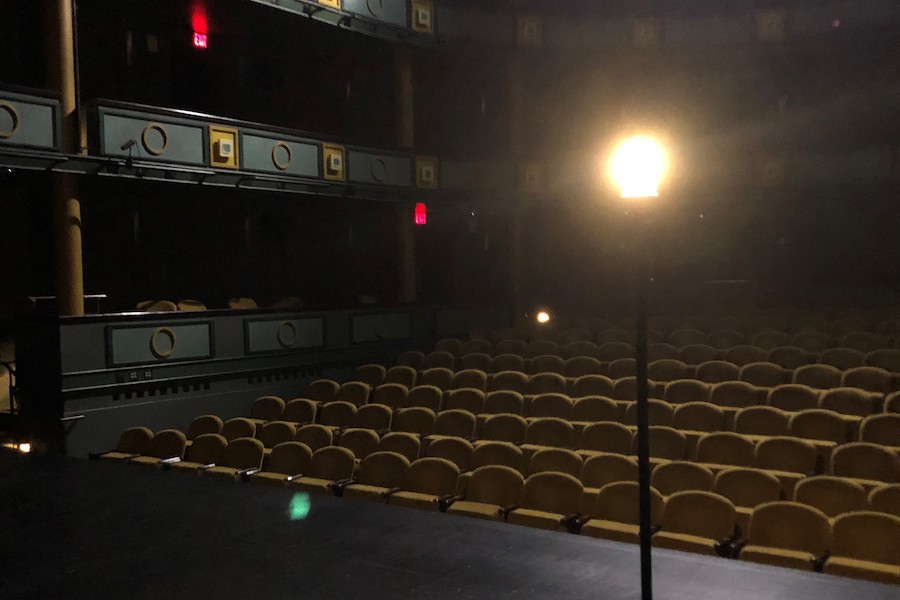As theatre workers continue to grapple with issues of racial injustice and concerns about unhealthy labor practices, as well as the challenges of putting on shows during the ongoing coronavirus pandemic, the industry has its share of real-life horrors to contend with. This piece, the latest installment of a Halloween series American Theatre has published each year since 2016, discusses frights of a different kind: ghost stories from across North America. As theatre districts begin to look less like ghost towns and the theatre field comes back to life, we hope these spooky tales can help raise your spirits.
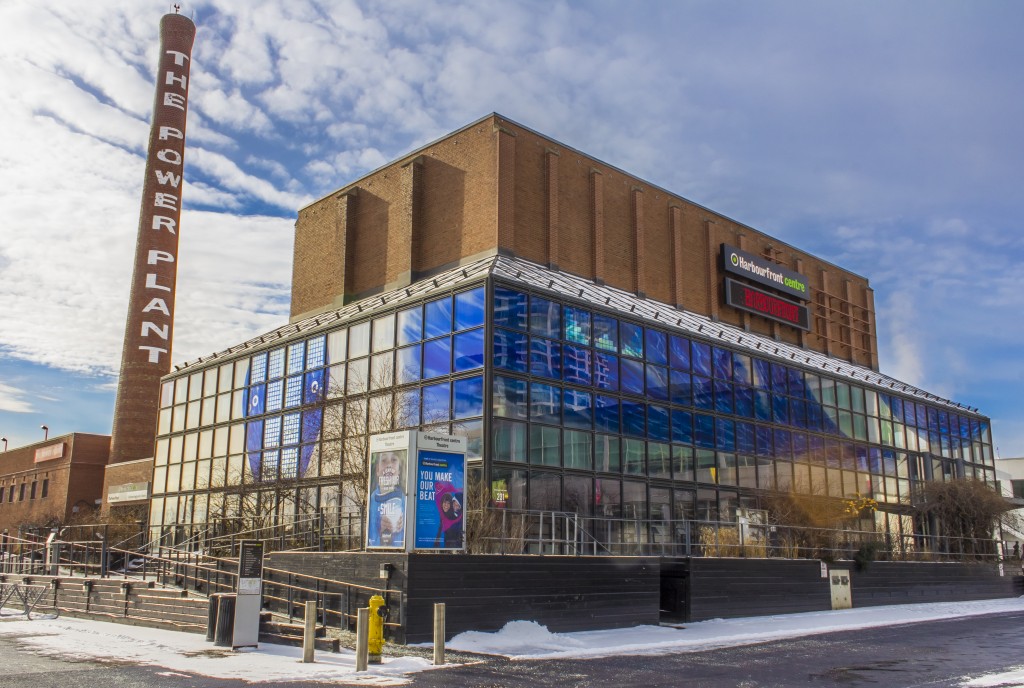
Harbourfront Centre Theatre, Toronto
When in 1998 Hilary Prue began working as an usher at the du Maurier Theatre Centre, now called the Harbourfront Centre Theatre, she heard about two spirits who allegedly inhabited the venue: a woman wearing a Victorian dress and a man sporting a bowler hat. Those fashions more or less align with the origins of the building, which was constructed on the shore of Lake Ontario in 1926 to hold ice used for shipping and storage. According to legend, that structure, known as the Ice House, became a temporary morgue after a boat sank in the harbor. “Rumor had it,” Prue says, “that at least one security guard quit after seeing one or both of those ghosts during a late-night lockup.”
Prue, who is now creating a podcast about disability representation in movies from the perspective of disabled people such as herself, initially didn’t encounter anything supernatural at the du Maurier. That changed when she joined the theatre’s office staff in 2000. She says it took some time for her to get accustomed to the noises of an old building with exposed air ducts, and she recalls one day when she was alone in the office “and heard a bloodcurdling scream. I checked—no one else was in the building.” At least one of her colleagues reported having a similar experience.
“What plagued me, though, was this feeling like I was being watched,” she notes. Several times when she was alone, “it was like someone was watching me from a low spot around a corner, then I would look and the air would rush away.” She adds that a few times she wondered if a co-worker of hers had come in with his children. “I thought that a kid was playing around, but this was never the case. Obviously this was disconcerting, but there wasn’t really anything to do about it. It became less frequent over time.”
She served as house manager and in other roles until 2004, and those occurrences stopped completely in 2001 or 2002, around the time another person began working in the office full-time. Current employees don’t have stories to share, but two TV shows about ghost hunting have recorded episodes at the theatre, and there have been several sightings over the years, including mysterious individuals observed in the house.
During Prue’s time at the du Maurier, such experiences led a handful of staff members to invite some local ghost hunters to check out the space. Prue helped keep that visit secret, to ensure that no possible paranormal intelligence would know about it in advance; she simply left a few doors open for staff to let in the crew. She says the ghost hunting group “spotted the woman in her Victorian dress, and the man with the bowler hat was following behind this group mimicking them and their sensors. But then they mentioned a third ghost: a little boy who hid from this group in the rafters of the theatre.” That’s when she realized: “Suddenly it all made sense—what I sensed in the office was a kid playing hide-and-seek. Part of me thinks it was a ghost and that he wanted to play but got tired of me not joining, or just got used to me being there and stopped watching.”
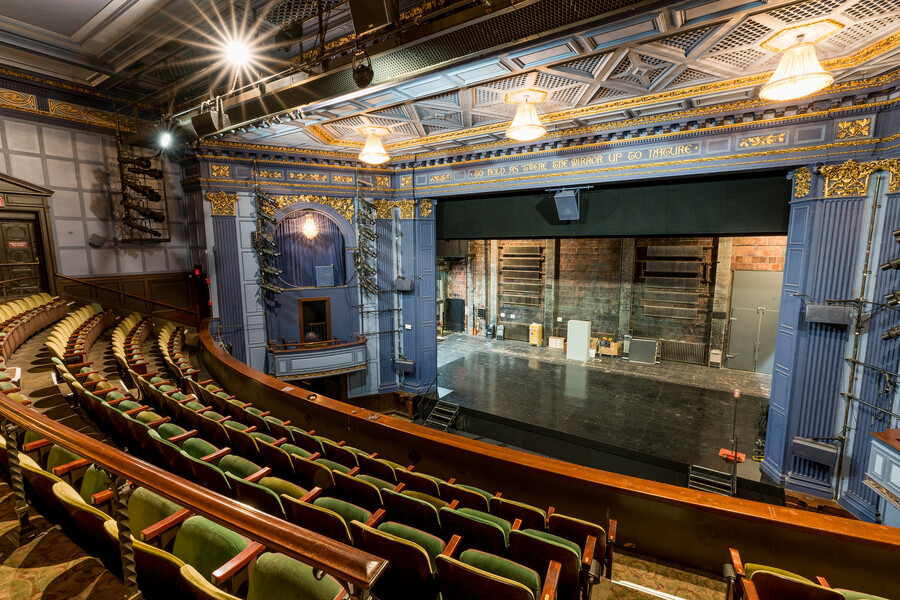
Huntington Theatre, Boston
Haunting a theatre isn’t always child’s play. The staff at the Huntington Theatre in Boston (formerly known as the Boston University Theatre and the Huntington Avenue Theatre) have come to accept that the founder of its first resident company continues to reside there. A painting of the Australia-born actor and manager, the namesake of the Henry Jewett Players, which opened the Repertory Theatre of Boston in 1925, hangs in the staircase in the building’s main lobby, and staffers of the current theatre company have learned to treat it with great care.
“We’re always very careful to make sure that everything’s perfect with his portrait or he gets upset,” attests Virginia V. Emerson (she/her), the Huntington’s assistant costume director. Of particular importance is the light that illuminates the painting, which depicts Jewett in costume as Macbeth. Emerson, who has worked for the organization since 1988, says she and her colleagues have found that if the light isn’t functioning properly, strange occurrences bring people to that side of the theatre until someone fixes the light. For instance, there may be a disturbance in the bathroom of the upper lobby when no one has been in that area for a while because the theatre has been dark for a week, or “for some strange reason, the UPS guy left packages in that lobby” instead of the other lobby, where deliveries are usually dropped off. During a repainting about a decade ago that required the portrait to be taken down, Emerson says there were minor glitches and technical issues throughout the building until it went back up. On one occasion, a Genie lift “worked perfectly fine one day,” but then “the next morning they went in, and, like, some piece had fallen off” that easily could have caused a serious accident if they hadn’t noticed.
To prevent these issues, the staff has taken pains to guarantee that Jewett is comfortable whenever they’ve needed to move the portrait. Emerson explains that for the current renovation, a complete overhaul, “the scene shop has built a special crate for his portrait,” replete with a light that’s kept on 24/7. In addition, the building manager “went out into the theatre and talked to all the ghosts and let them know what was going on, all the things that were going to get torn out, what was going to stay, and how long it was going to take and assured them that we would all be back.” Emerson and several of her colleagues in the costumes department did the same with the wardrobe stock rooms so any spirits there “wouldn’t get upset, because we want our renovations to go smoothly.”
Based on the sightings over the years, those precautions may be warranted. Many years ago, when the production manager for Boston University at the time was early in his tenure, late one night after a dress rehearsal he neglected to turn on the lights of the first-floor hallway as he walked to his office, so it was dark other than the streetlight coming in from the alley through a window in that area. “So it was backlit,” Emerson says, “and he looked down the hallway and could clearly see Henry looking just as he does in his portrait, in costume as the Scottish King.”
Emerson and others have also observed a piano playing on its own. When a small upright rehearsal piano was stored on the basement level near the dressing rooms, sometimes music could be heard, showtunes from the 1930s and ’40s. “On a couple occasions,” she says, “I heard the piano, and when I stepped out into the hallway, there was nobody there.” The company learned more about their paranormal neighbors when, around 15 years ago, a medium visited the theatre. Emerson says the medium suggested that the piano player’s name was Leo and that he played for the spirit of a singer and showgirl named Gloria who had starred in musicals. Since learning that information, Emerson says she and others will respond to the piano playing by stepping into the hallway and calling out, “Hey, Leo, how you doing?”
Emerson also remembers an apparition being spotted at the opening night of a play that happens to feature a ghost, the company’s 2008 co-production with Chicago’s Goodman Theatre of Conor McPherson’s Shining City. During a scene in which the characters discuss the ghost, a mysterious figure appeared onstage “and kind of waved at the audience” and faded away. That specter was observed by another member of the costume shop who has worked for the company for more than three decades. As Emerson notes, with few Boston-area theatres that feature costuming on the Huntington’s level, “when you find a place, you stick around.” It seems the same is true of the theatre’s ghosts.
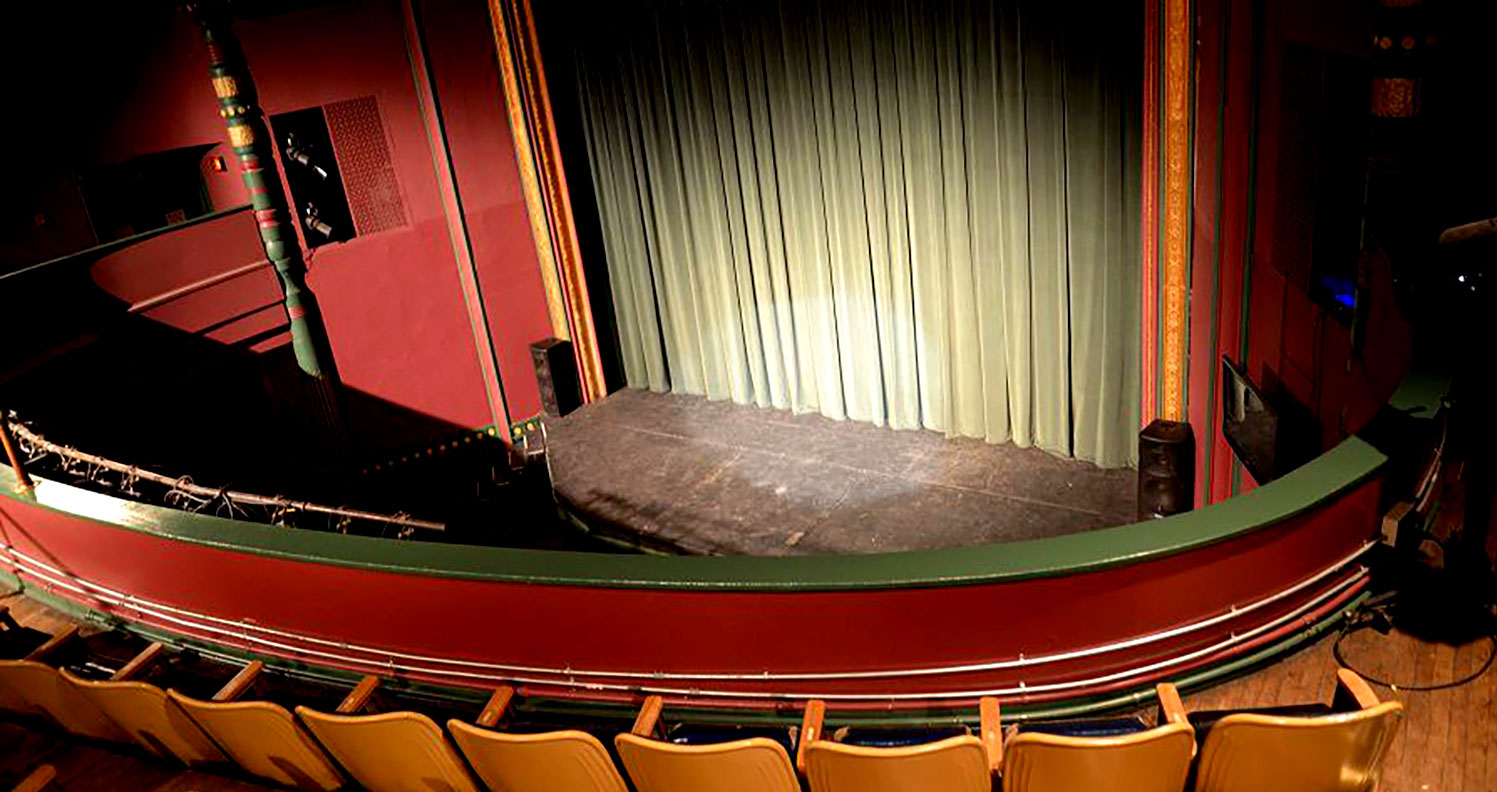
Academy Theatre, Meadville, Pa.
For New York City-based actor and barista Kayla Styborski (she/they), ghostly encounters took place not at a theatre but after they spent time in one. In 2011 Styborski participated in a youth theatre camp at the Academy Theatre, where they heard tales of a ghost named Ernie—Ernest P. Hempstead, that is, the former newspaper editor whose efforts led to the construction of the theatre in 1885. They went on to perform in shows at the Academy, also working backstage and helping with box office and concessions. “Everyone there, if they feel a little uneasy in the theatre by themselves,” they say, “will go ‘Hi, Ernie!’ to feel better and know they’re not alone.”
While those efforts seemed to keep Hempstead’s specter at bay, on a few occasions beginning in 2016, strange things happened that suggested he followed Styborski out of the theatre, and they could sense his presence “on the car rides home or in my house.”
How did they know it was him? “I had some candles on top of an old TV in my room, and some days—when they weren’t lit, thankfully—they would just fall over. No sounds or anything would cause it, they would just fall. Eventually I caught on that it would happen after I was at the Academy.” But sure enough, when Styborski called out “Ernie!” the issues would stop for a while. A couple of their friends had studied supernatural phenomena, but even those folks couldn’t figure out why the spirit was following them. At least they learned the importance of greeting Ernest.
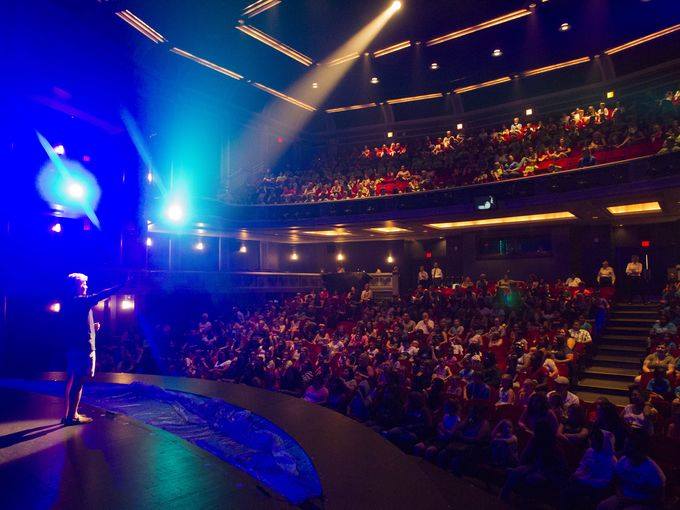
Valley Youth Theatre, Phoenix, Ariz.
Like the spirits associated with the Huntington and the Academy, the ghosts that allegedly inhabit Valley Youth Theatre seem to have an affinity for light sources. General manager Tiffany Owen (she/her) reports that several people, including leaders and creative staff, “believe there are two ladies who typically occupy the front part of our theatre: loft, lobby, booth.” There isn’t definitive information on how they came to identify these ghosts, but the structure has served a variety of purposes, so countless people have passed through: “Our building has been many things over the years,” explains Owen, “from one of Phoenix’s first auto dealerships in the 1940s to an antique shop to the theatre it has been for the last 22 years.” Owen says their ghosts “have been known to turn lights on and off in the house or the lobby when there were one or two people in the building and no one was near a switch. I’ve seen them walk through our booth from a distance multiple times while locking up after rehearsal.”
Owen, who’s been on staff since 2014, mentions that she “grew up dabbling in the paranormal: seances, Ouija boards, etc.,” so she believes she may be a bit more sensitive to the presence of spirits than others in the organization. Thankfully, the theatre’s supernatural inhabitants appear to be friendly ghosts: “They seem content to reside there and generally not bother anyone,” Owen says, “but I always make a point to say hello and good night.”
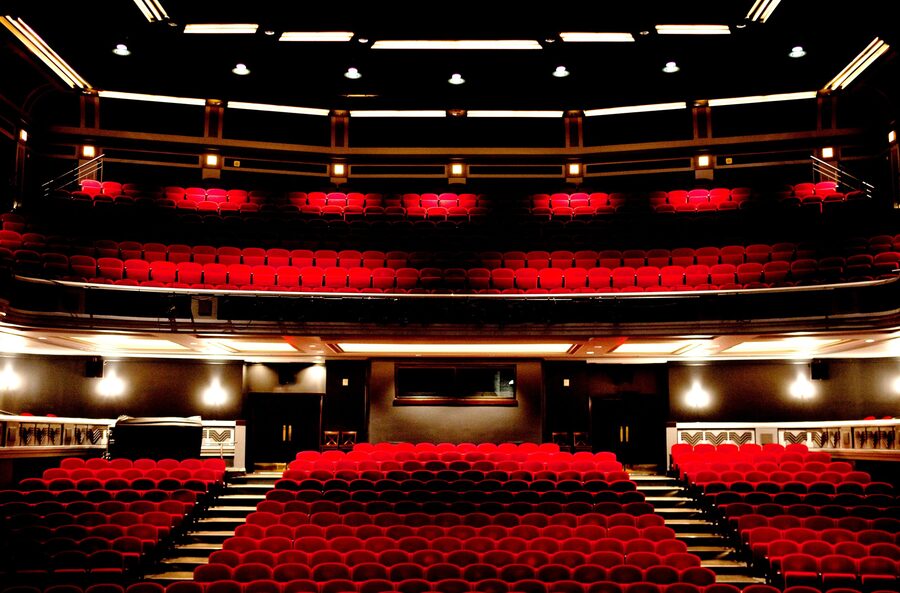
Herberger Theater Center, Phoenix, Ariz.
Phoenix may be something of a hot spot for paranormal activity, because the Herberger Theater Center—whose resident organizations include Arizona Theatre Company, Childsplay, iTheatre Collaborative, Arizona Broadway Theatre, and Arizona Opera—has also reported several ghost sightings.
Director of production services and facilities Tami Updegraff (she/her) first began working there in 1995 as an over-hire technician. She joined the staff in a full-time capacity in 2003 for a few years, then returned in 2011, at which point she “started feeling like I might not be as alone as I thought I was. For me it is always in Stage West stage left, when I am locking up the building.” Updegraff notes that, while she doesn’t believe she’s particularly “sensitive to the supernatural, I am fairly certain I have seen and felt an apparition while locking up the theatre on several occasions.”
One night in 2015, when Updegraff was certain she was alone in the building “and had been for hours, I went in to lock up one of our spaces and saw the stage right side tab curtain move as if someone had pulled it aside and wrapped themselves in it—like a child might playing hide-and-seek.” Is it possible someone was actually there? “There was no logical explanation for the side tab curtains to be moving,” she says. “I turned on the work light as I approached and found absolutely nothing but the curtain itself with a little sway in it. Chills shot through me. It was not possible they were moving with the air ventilation/AC because I personally had turned those off earlier in the day.” The incident took place just after Center Dance Ensemble closed its staging of Shakespeare at the Herberger, which included dances inspired by several plays by the Bard, including Macbeth. Updegraff thinks it was no coincidence that her first ghostly encounter followed a production adapted in part from the Scottish Play. “It was practically an invitation,” she says.
The incident after Shakespeare at the Herberger was hardly the staff’s first interaction with a spirit. Mark Mettes (he/him), president and CEO since 1990, recalls one such encounter that took place around 2000 in the dimmer room that overlooks the deck of Stage West from the fifth level of the building.
“The enclosed room takes up about a third of the level, with electrical disconnects and cabling taking up a large portion of the other space,” explains Mettes. “The only way up to that level is by a steel ladder attached to the back wall outside the dimmer room.” He says a technician from an outside company was in that room with the door open while servicing the dimmer system. “The technician was involved in his work but noticed out of the corner of his eye that a man in overalls came up the ladder and slowly walked toward the dimmer room. Instead of walking into the room, the man walked past it and down a narrow area between the room and the railing.” Mettes continues: “Assuming the man was looking at something before coming into the room, the technician continued his work. After several minutes without seeing or hearing the man, the technician decided to look and see what the man was doing.” That narrow area where the mysterious figure walked past led to nothing but a brick wall and a railing five floors above the stage, but the man was nowhere to be found. “The area was empty. Shaken, the technician decided it was time to take a break and went down to the ladder and outside to smoke a cigarette, which is where he relayed his story to us.”
Ghosts seem to be especially attracted to the Herberger Theater’s lighting areas. Senior production supervisor of lighting Greta Haug (she/her), who’s been on staff since 2003, recalls sitting in the light booth one night around 2008 waiting for the show to start. “The light booth is a long room with doors on either side; I was sitting at the light board in the middle of the room, facing the door that we always use,” she recounts. “No one ever uses the other door, as it’s very inconvenient to get to, particularly when the audience is being seated,” as was the case in that moment. Then it happened: “In a completely quiet room, I heard the unmistakable sound of the door behind me opening and then closing. I turned, but there was no one there. I could see the catwalks outside that door, and there was also no one there. I’m sure I wasn’t alone that night.”
Audience members have seen apparitions as well. Just last month, during a stand-up performance by Max Amini, attendees noticed some unusual things. Mariam Kumar, vice president of Engineering Alliance, says she saw, out of the corner of her eye, a spirit jumping over the seats while people entered the auditorium before the show. What she noticed “reminded me of a mischievous teenage boy,” she says. “He was dressed in an old paperboy suit and hat.” Then, an hour or so into the set, “the comedian stopped, looked around for a few seconds and said, ‘I swear someone just walked behind me!’” At that exact moment she saw a black shadow or mass about the size of a beach ball on the house left side of the stage. On her way home she mentioned what she saw to a friend who was also at the show, and he said he noticed the black shadow too. Kumar admits she doubted herself because she’s seen paranormal entities before, and was shocked that both of them experienced it this time. “It was comforting to know another person saw the same thing as I did.”
Marketing manager Mark Mettes Jr. (he/him), who has been with the organization since 2016 and was in the crowd that night, confirms that no one could have been onstage with Amini. “I can tell you he was far enough upstage that nothing would have been near him and nothing was happening behind him,” Mettes says. If it was a ghost, what was it doing there? Amini happened to be performing the show on his birthday, so perhaps the spirit wanted to celebrate with him.
It’s no surprise that the staff continues to be mindful about ghosts in the building. Since her initial experience in 2015, Updegraff says, “I tend to turn the lights on when I first walk in, though failed to do so about a week ago and was reminded why as I walked through—instant shivers.” Other than the excitement at the comedy show last month, though, there haven’t been many paranormal encounters lately, given the realities of the pandemic. “We, along with the rest of the world, were shut down for over a year, and during that time definitely kept the ghost light plugged in.”
Russell M. Dembin (he/him) is a former managing editor of this publication.

